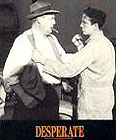|
|
|
|
Desperate
|
 |
|
Blast From the Past One night in the late '90s, I took down from the shelf a movie I had taped off late night TV about five years previously, but never watched. It was a low-budget action film noir directed and co-written by Anthony Mann, Desperate. What nudged me into finally watching this movie was this: in a book published only a couple of years earlier than my viewing, the remarkable and authoritative 50 ans de Cinéma Américain by Jean-Pierre Coursodon and Bertrand Tavernier (Nathan 1995), Desperate is described as a film containing "violence ... not excluding a certain sadism" (p. 692). This immediately intrigued me: we all have some working idea of what a violent-sadistic movie from 1997 or 1967 looks like. But a violent-sadistic movie from 1947? There is nothing more salutary and disconcerting than looking at an old violent movie, a movie once designated as violent in another time and another culture. Such a viewing experience immediately alerts you to how screen violence isn't one, unchanging, obvious thing at all, but a completely constructed thing, always with its own codes and conventions. And the construction of violence, the artifice of violence, those codes and conventions, change rapidly and wildly with the tides of history. I find a particular scene of violence from Desperate completely fascinating. It does indeed impress and shock me, sitting on a couch in 1997, as a violent and brutal scene in its overall mood and effect. What is notable about this quite brilliantly directed fragment is the diversity of kinds of violence in it. There is direct, graphic violence, rendered in a sudden, extreme, unexpected way: Raymond Burr's fist in super close-up whacking out that poor patsy. Far more intricately, there is a whole violence of form, of style, going on right across this sequence. Mann is a filmmaker who really takes the mood, the event, the ethos of violence right into the fine grain of how he shoots and lights, stages and renders action. There's violence in the choice of angles and edits, violence in the stark spatial distortions and play-offs of foreground and background, violence in the slow, crawling movements of bodies as in the sudden, impactful ones. Above all, there's violence in the lighting, in the oldest cliché of action-thriller lighting that is here brought magnificently to life: I mean the disturbed, swinging lightbulb that, in an exaggerated way, keeps plunging us in and out of absolute dark and blinding light, like an early strobe-flicker effect. (For more on the archaeology of this effect in the work another filmmaker who is also surprising to study today, see my text on Robert Aldrich.) In terms of the changing history of screen violence, there's one special aspect of this scene that strikes me as particularly modern and contemporary, an amazing portent of our time and our conventions. It's the aspect that I think 50 ans was describing as "sadistic". This sadism arises mainly from a certain hardboiled use of words, language, dialogue in the scene. Raymond Burr advances menacingly with a broken bottle and starts spreading the dread around; he's talking creepily about the hero's "pretty wife", concluding: "She won't look so good anymore". This could easily be, with a few minor alterations, a bit of business from a Quentin Tarantino movie, one of those slow-burn moments where a character is preyed upon menacingly – and so is the audience. It's a sadism aimed at the viewer as well as the fictional character. MORE Mann: Raw Deal © Adrian Martin June 1999 |
![]()